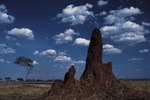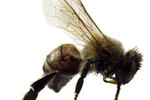Most commonly, the residents in an ant farm are harvester ants. No matter which species ends up in your ant farm, though, you may want to know more about these ants, including where they come from, how their society functions, what they eat and how they can threaten their native environments.
Harvester Ant Homes
Hundreds of species of harvester ants exist worldwide. In the United States, most native harvester ant species make their homes west of the Mississippi River because they prefer dry, desertlike conditions. In fact, the species most commonly found in ant farms is the Texas Red Harvester Ant (Pogonomyrmex barbatus).
Harvester Ant Society
Like most ant species, harvesters live in colonies centered around a queen. The queen never leaves the colony; her job is to produce new ants. Most of the queen’s offspring become worker ants. These ants cannot reproduce; instead, they defend the colony, find food and maintain their home. Worker ants lack wings, but the queen will produce some male and female offspring with wings. Their job is to fly out into the world, find mates, reproduce and start new colonies of harvester ants. On average, a harvester colony will contain 10,000 individuals.
Harvester Ant Anatomy
Like other ants, harvester ant bodies consist of three main parts: the abdomen, thorax and head. Like all insects, harvester ants have six jointed legs each and hard exoskeletons that protect their bodies. Harvester ants are larger than many ants. Queen harvester ants are at least a half-inch long while workers are about half that size. In comparison, little black ants (Monomorium minimum) are only one-sixteenth of an inch long. Harvester ants have fine hairs on the bottoms of their heads. Harvester ant species can be red, black, reddish-brown or yellow.
Ant Farm Society
Although ant farms will let you watch the busy insects do their work, you don’t get to see the actual societal structure of harvester ants. To prevent captive harvester ants from infiltrating new habitats and threatening native species, ant farms are populated only by sterile female worker ants. Consequently, your ant farm will not have a queen, so your ants will not produce a new generation of worker ants.
If you choose to order ants to populate your farm, you will receive adult worker ants. These ants will live approximately one to three months. When they die, you will need to do the following to prepare the farm for a new batch of workers:
- Take apart the farm.
- Sift the sand to remove any ants, food or other debris -- or dispose of it and replace it with new sand.
- Run water over the plastic parts of the farm.
- Dry the pieces.
- Put the farm back together.
- Add the sifted or new sand back into the farm.
Tips
When drying the ant farm, do not rub the pieces. Rubbing them can scratch the plastic.
If you want your ant farm to more accurately represent harvester ant society, collect your own ants from your local environment. Get all of the collected ants from the same colony, or they will fight one another.
Feeding Harvester Ants
While ant farms come equipped with the nutrition your harvester ants need, they are not as lucky in the wild. Worker ants will travel 30 to 40 feet from their colonies to collect seeds. To do this without getting lost, the workers create a scent trail using pheromones produced within their glands so they can smell their way back to the colony.
When they do return to the colony, the workers grind up the seeds with their mandibles and create something similar to bread. They store these loaves within the colony to provide an ample supply of food.
Journeying to collect these seeds can be dangerous for the ants. The horned lizard, for example, lives almost solely on red harvester ants.
Problems With Harvester Ants
Although harvester ants are small, they can do considerable damage. Their mounds alone can have a diameter of nearly 4½ feet, and these mounds can cause problems. Western harvester ants, for example, sometimes build their large colony mounds close enough to sidewalks to damage them. In pastures and lawns, colony mounds may be circled by 3 to 6 feet of barren ground that lacks vegetation thanks to the ants’ foraging. Texas red harvester ants are capable of doing so much damage that they have reduced farming output.
Harvester ants, particularly the red ones, can also deliver painful stings. The workers use their stinging capabilities to defend the colony. Those stings can cause pain for several hours and can produce allergic reactions in some people. Their large mandibles also allow them to deliver painful bites despite their small size.
Writer Bio
Amy Jorgensen has ghostwritten more than 100 articles and books on raising and training animals. She is also an amateur dog trainer. She has also written more than 200 blog posts, articles, and ebooks on wedding and party planning on behalf of professionals in the field.





